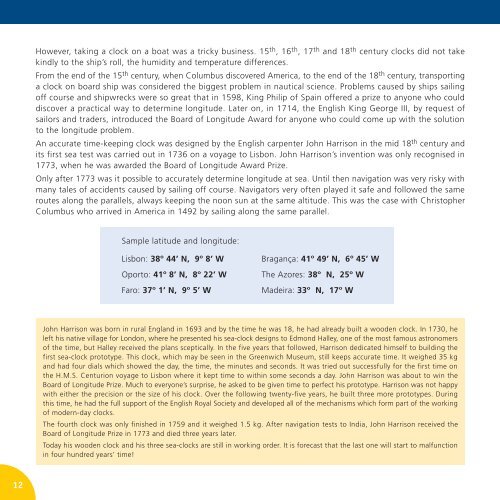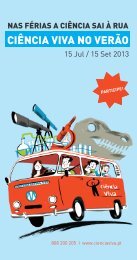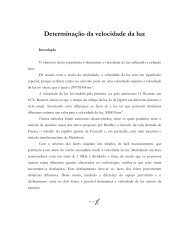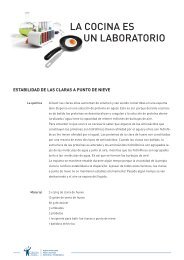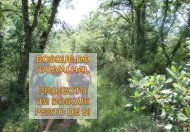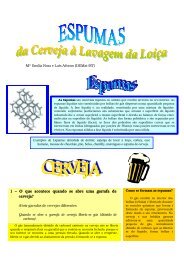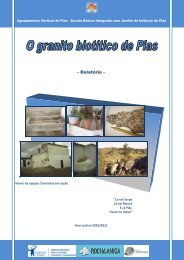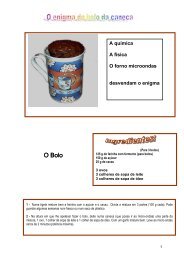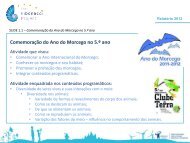Latitudes and Longitudes - Ciência Viva
Latitudes and Longitudes - Ciência Viva
Latitudes and Longitudes - Ciência Viva
Create successful ePaper yourself
Turn your PDF publications into a flip-book with our unique Google optimized e-Paper software.
12<br />
However, taking a clock on a boat was a tricky business. 15th , 16th , 17th <strong>and</strong> 18th century clocks did not take<br />
kindly to the ship’s roll, the humidity <strong>and</strong> temperature differences.<br />
From the end of the 15th century, when Columbus discovered America, to the end of the 18th century, transporting<br />
a clock on board ship was considered the biggest problem in nautical science. Problems caused by ships sailing<br />
off course <strong>and</strong> shipwrecks were so great that in 1598, King Philip of Spain offered a prize to anyone who could<br />
discover a practical way to determine longitude. Later on, in 1714, the English King George III, by request of<br />
sailors <strong>and</strong> traders, introduced the Board of Longitude Award for anyone who could come up with the solution<br />
to the longitude problem.<br />
An accurate time-keeping clock was designed by the English carpenter John Harrison in the mid 18th century <strong>and</strong><br />
its first sea test was carried out in 1736 on a voyage to Lisbon. John Harrison’s invention was only recognised in<br />
1773, when he was awarded the Board of Longitude Award Prize.<br />
Only after 1773 was it possible to accurately determine longitude at sea. Until then navigation was very risky with<br />
many tales of accidents caused by sailing off course. Navigators very often played it safe <strong>and</strong> followed the same<br />
routes along the parallels, always keeping the noon sun at the same altitude. This was the case with Christopher<br />
Columbus who arrived in America in 1492 by sailing along the same parallel.<br />
Sample latitude <strong>and</strong> longitude:<br />
Lisbon: 38º 44’ N, 9º 8’ W<br />
Oporto: 41º 8’ N, 8º 22’ W<br />
Faro: 37º 1’ N, 9º 5’ W<br />
Bragança: 41º 49’ N, 6º 45’ W<br />
The Azores: 38º N, 25º W<br />
Madeira: 33º N, 17º W<br />
John Harrison was born in rural Engl<strong>and</strong> in 1693 <strong>and</strong> by the time he was 18, he had already built a wooden clock. In 1730, he<br />
left his native village for London, where he presented his sea-clock designs to Edmond Halley, one of the most famous astronomers<br />
of the time, but Halley received the plans sceptically. In the five years that followed, Harrison dedicated himself to building the<br />
first sea-clock prototype. This clock, which may be seen in the Greenwich Museum, still keeps accurate time. It weighed 35 kg<br />
<strong>and</strong> had four dials which showed the day, the time, the minutes <strong>and</strong> seconds. It was tried out successfully for the first time on<br />
the H.M.S. Centurion voyage to Lisbon where it kept time to within some seconds a day. John Harrison was about to win the<br />
Board of Longitude Prize. Much to everyone’s surprise, he asked to be given time to perfect his prototype. Harrison was not happy<br />
with either the precision or the size of his clock. Over the following twenty-five years, he built three more prototypes. During<br />
this time, he had the full support of the English Royal Society <strong>and</strong> developed all of the mechanisms which form part of the working<br />
of modern-day clocks.<br />
The fourth clock was only finished in 1759 <strong>and</strong> it weighed 1.5 kg. After navigation tests to India, John Harrison received the<br />
Board of Longitude Prize in 1773 <strong>and</strong> died three years later.<br />
Today his wooden clock <strong>and</strong> his three sea-clocks are still in working order. It is forecast that the last one will start to malfunction<br />
in four hundred years’ time!


